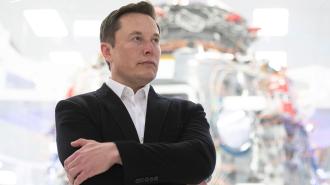While Russian military forces are asleep, an elite Ukrainian drone unit is taking out their tanks — using an internet service provided by SpaceX CEO Elon Musk.
The background: Soon after Russia invaded Ukraine on February 24, several parts of the nation began experiencing internet connectivity issues, leading to fears that Russia would ultimately try to disconnect all of Ukraine.
“[Ukraine is] using thousands, in the area of thousands, of terminals with new shipments arriving every other day.”
Mykhailo Fedorov
In an attempt to prepare for such a situation, Ukraine’s Vice Prime Minister Mykhailo Fedorov reached out to Musk via Twitter on February 26, asking the billionaire entrepreneur to send Starlink satellite internet ground stations to Ukraine.
Musk agreed within hours, and on March 20, Fedorov told the Washington Post through a translator that Ukraine is “using thousands, in the area of thousands, of [Starlink] terminals with new shipments arriving every other day.”
The strikes: The Times of London has now reported that an elite unit of Ukrainian drone pilots is relying on the Starlink service to carry out its missions.
The group is called the “Aerorozvidka,” and it’s currently conducting about 300 missions a day — these range from reconnaissance operations to dropping anti-tank grenades on high-priority Russian targets at night.
“We use Starlink equipment and connect the drone team with our artillery team.”
Aerorozvidka officer
The group has been hailed as one of Ukraine’s most valuable weapons, and it has been using Starlink’s satellite internet to ensure spotty terrestrial internet conductivity doesn’t jeopardize its missions.
“We use Starlink equipment and connect the drone team with our artillery team,” an Aerorozvidka officer told The Times. “If we use a drone with thermal vision at night, the drone must connect through Starlink to the artillery guy and create target acquisition.”
The private sector: While it’s important for the Aerorozvidka and the rest of Ukraine’s military to have internet access during Russia’s invasion, it’s also vital for the nation’s civilians.
“Internet connection is really important here in Ukraine,” Oleg Kurkov, an engineer in Ukraine, told WaPo. “We are getting a lot of info from social media channels, from the government, and from each other.”
The group conducts about 300 missions a day, ranging from reconnaissance operations to bombings of Russian targets.
Kurkov had previously purchased a Starlink terminal just so that he could disassemble it to see how the device worked. When he heard that Musk was enabling Starlink connectivity in Ukraine, he quickly put it back together.
Now, if a Russian attack knocks out his primary source of internet, he knows he’ll be able to access the internet being beamed down from a constellation of satellites in space.
We’d love to hear from you! If you have a comment about this article or if you have a tip for a future Freethink story, please email us at [email protected].






